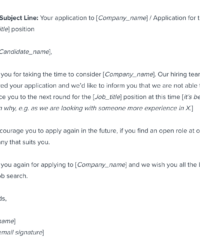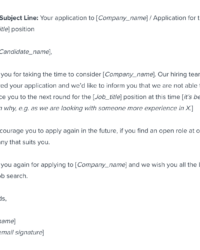Utilizing a pre-designed structure for candidate rejection offers several advantages. It saves time and resources by eliminating the need to draft individual rejection letters from scratch. A well-crafted format ensures all necessary information is conveyed, such as the reasons for the decision (if appropriate) and next steps for the candidate. This consistent messaging also reinforces the organization’s brand and values, even in potentially negative interactions.
The following sections will delve into specific examples and best practices for creating and implementing these valuable resources in various recruitment scenarios.
Key Components of a Candidate Rejection Communication
Effective rejection communications require specific elements to ensure clarity, professionalism, and a positive candidate experience, even in an undesirable outcome.
1. Company Letterhead/Branding: Maintaining consistent branding reinforces professionalism and recognition.
2. Date: A clear date provides a reference point for both the organization and the applicant.
3. Applicant’s Name and Address: Accurate addressing demonstrates respect and attention to detail.
4. Salutation: A formal and respectful salutation sets the tone for the communication.
5. Expression of Gratitude: Acknowledging the applicant’s time and effort is a courteous gesture.
6. Clear and Concise Statement of Rejection: Directly stating the decision avoids ambiguity and saves the applicant time.
7. Explanation of the Decision (Optional but Recommended): Providing context, when appropriate, can be helpful for the applicant’s future job search. This should be carefully worded to avoid legal issues and focus on job requirements, not personal characteristics.
8. Next Steps (If Applicable): Information regarding future opportunities or feedback processes can leave a positive impression.
9. Closing: A professional closing and signature finalize the communication appropriately.
Careful consideration of each element contributes to a well-crafted communication that respects the applicant while protecting the organization’s interests.
How to Create a Candidate Rejection Letter Template
Creating a standardized template for declining job applications ensures consistency, professionalism, and efficiency in the hiring process. A well-structured template allows organizations to communicate respectfully with all applicants while minimizing time spent on individual responses.
1. Choose a Professional Format: Select a business letter format, ensuring clear sections for essential information. Consistency in font, spacing, and margins promotes a polished image.
2. Incorporate Company Branding: Add a company logo and use brand colors if appropriate. Visual consistency reinforces brand identity.
3. Include Placeholder Fields: Designate spaces for personalized information such as the applicant’s name, the specific position applied for, and the date. These fields will be populated for each individual communication.
4. Craft a Respectful Opening and Closing: Use formal salutations and closings. Express gratitude for the applicant’s interest and time.
5. State the Decision Clearly and Concisely: Avoid ambiguity by directly stating the rejection decision. Unnecessary elaboration can create confusion or false hope.
6. Offer Optional Explanation (with Caution): Briefly explaining the decision, while avoiding specific details about other candidates, can be helpful. Focus on the requirements of the role and how the chosen candidate’s qualifications were a closer match. Exercise caution to avoid legal risks or negative implications.
7. Consider Including Next Steps (Optional): Depending on the organization’s policies, offering information on future opportunities or feedback mechanisms can leave a positive lasting impression.
8. Review and Refine: Before implementing the template, thoroughly review for clarity, tone, and legal compliance. Ensure the language remains professional, respectful, and avoids any potential misinterpretations.
A thoughtfully crafted template streamlines communications, ensuring each applicant receives a timely and respectful response, while also protecting the organizations reputation and legal standing. Regular review and refinement of the template helps maintain its effectiveness and relevance within the evolving hiring landscape.
Standardized rejection communications represent a crucial element of professional and legally sound recruitment practices. From ensuring consistent messaging to protecting organizational interests, the utilization of thoughtfully constructed templates offers significant benefits. Key components such as clear communication, respectful tone, and appropriate information delivery contribute to a positive candidate experience, even in the context of an unsuccessful application. Careful consideration of legal implications and consistent review of template content ensures ongoing effectiveness and relevance.
Ultimately, the strategic implementation of these resources demonstrates an organization’s commitment to ethical and efficient hiring processes, fostering a positive reputation among candidates and contributing to a stronger employer brand. Continuous refinement and adaptation of these tools to evolving best practices will remain essential for organizations seeking to maintain a competitive edge in talent acquisition.


